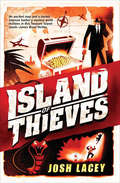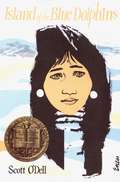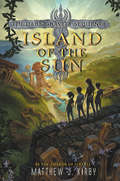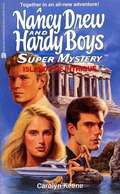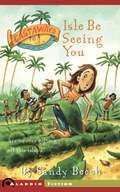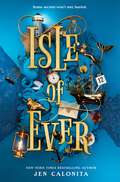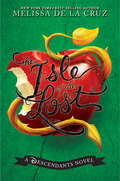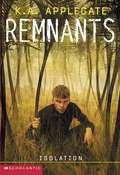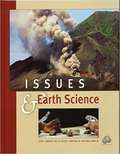- Table View
- List View
Island of Thieves
by Josh Lacey"Only boring people get bored...Interesting people can always find something to be interested in." That's what Tom Trelawney's father says, anyway. Tom shouldn't have been interested in playing with matches but he was...bored. Now the shed is in ashes and strange Uncle Harvey is the only one willing to have him stay while his parents vacation. Tom soon discovers Harvey is going to South America on a treasure hunt and though nephews aren't invited, he manages to tag along. Before it's over he'll drive a car, fire a gun and run for his life. Tom realizes that life may be about following the rules, but survival may be about breaking them.
Island of the Blue Dolphins and Related Readings
by Scott O'DellRecords the courage and self-reliance of a Native American girl who lived alone for eighteen years on an isolated island off the California coast when her tribe emigrated and she was left behind. Includes additional fiction, poetry and non-fiction articles related to the subject.
Island of the Blue Dolphins: Instructional Guides For Literature
by Scott O'DellThe gripping story of young Karana, who survives by herself for eighteen years on a deserted island off the California coast.<P><P> Newbery Medal winner
Island of the Sun
by Matthew J. KirbyPerfect for fans of the Percy Jackson and Seven Wonders series, Island of the Sun is the second book in an epic, fast-paced middle grade adventure trilogy by acclaimed author Matthew J. Kirby.Eleanor and her friends have shut down the mysterious Concentrator in the Arctic, but their mission is far from over. The earth is still spinning out of its orbit and growing colder by the day. Their only chance is to find the other Concentrators embedded around the world and deactivate them before it's too late.But doing so won't be easy. The Global Energy Trust has branded Eleanor, her mother, and their friends international terrorists and is tracking their every move. The G.E.T. will stop at nothing to harness the power of the Concentrators in order to preserve the select few people its leaders deem worthy, and Eleanor is soon forced to ask herself whether it's worth risking the lives of the entire human race for a slim chance to save it.
Islands of Intrigue (Nancy Drew & Hardy Boys SuperMystery #27)
by Carolyn KeeneNancy and Bess are vacationing in Greece at the same time as Joe and Frank Hardy are there pursuing a renegade American operative suspected of stealing missiles. Together, they set off on a spine-tingling Greek odyssey across a sea of duplicity, danger, and imminent destruction.
Isle Be Seeing You
by Sandy Beech Jimmy HolderI'm at the end of my rope! Like getting shipwrecked and surviving a hurricane weren't bad enough! Now I've got to support my sort of boyfriend's plan to get off this island, even though I think his idea's kinda lame. But with everything going so well between us, I don't want to rock the boat...er...make waves...well, you know what I mean! Especially with Evil Angela supporting Josh's plan all the way. I wish I knew what to do. The stakes are pretty high now. And I can't help wondering if maybe, just maybe, there's another way to get back home....
Isle of Ever (Isle of Ever #1)
by Jen Calonita"[An] atmospheric fantasy ride."—Publishers Weekly, STARRED REVIEW"Fast-paced and satisfying."—School Library Journal, STARRED REVIEW"I couldn't put it down!"—Stuart Gibbs, New York Times bestselling author of the Spy School seriesTwo hundred years ago, an island disappeared. Benny has just two weeks to find it.Everly "Benny" Benedict and her mom have always managed to get by, though they're broke most of the time. But all that could change. Benny's just learned she's the sole heir to the vast fortune of Evelyn Terry, a mysterious ancestor from the 1800s!There's a catch, though. First Benny needs to play—and win—a game: following clues that are more than a century old, she must find her way to the tiny island Evelyn wrote about in her diary. It was somewhere off the shoreline of Evelyn's home town, but according to legend, it vanished long ago and hasn't appeared on maps for hundreds of years. Yet Benny has only a couple weeks to locate it.If she's successful, she'll collect the inheritance. But what if there's more than a fortune at stake in this game? What if Benny has to break an ancient curse to win?
Isle of the Lost, The-A Descendants Novel, Vol. 1 (Descendants)
by Melissa de la CruzEvil tree. Bad Apple? Twenty years ago, all the evil villains were banished from the kingdom of Auradon to the Isle of the Lost--a dark and dreary place protected by a force field that makes it impossible for them to leave. Stripped of their magical powers, the villains now live in total isolation, forgotten by the world. Mal learns from her mother, Maleficent, that the key to true darkness, the Dragon's Eye, is located inside her scepter in the forbidden fortress on the far side of the island. The eye is cursed, and whoever retrieves it will be knocked into a deep sleep for a thousand years. But Mal has a plan to capture it. She'll just need a little help from her "friends." In their quest for the Dragon's Eye, these four kids begin to realize that just because you come from an evil family tree, being good ain't so bad.
Isolation (Remnants Series #7)
by K. A. ApplegateThe end of the world has come . . . and gone. Three groups race to gain control of the ship and Mother, a computer that runs the ship and has been dictating the Remnants' every move. Mother is also the only chance the Remnants have to build a new Earth by harnessing her power to create environments. Billy knows Mother's true power firsthand--and it may be indestructible. The Remnants' conflict rushes toward something so finite, so unbelievable, weapons will be dropped, fighting will stop for a time . . . and new enemies will emerge.
Issues & Earth Science
by University of California at Berkeley Lawrence Hall of ScienceNIMAC-sourced textbook
Issues & Life Science
by University of California at Berkeley Lawrence Hall of ScienceNIMAC-sourced textbook
Issues and Earth Science: Geological Processes, Revised
by Lawrence Hall of Science University of California BerkeleyNIMAC-sourced textbook <p>Where should we store our nuclear waste? Students learn about both gradual and sudden changes to the Earth’s surface, what causes them, and how they are monitored. They also explore how different kinds of rocks are formed and learn about some natural resources, where we find them, and how we use them. PE Assessment Example: Would you select one of the four suggested sites for storing nuclear waste? Explain. Use evidence from this unit to support your decision and identify any trade-offs. Geological Processes is part of Issues and Science three year middle school program, designed by SEPUP at the Lawrence Hall of Science. This six to seven week unit anchors the lessons around the the socio-science issue: Where should we store our nuclear waste? Investigative phenomena within the 18 activities connect back to the issue and storyline. This unit builds towards and assesses PEs ESS2-1, ESS2-2, ESS2-3, ESS3-1, ESS3-2. The Student Book guides students in exploring a socio-science issue and connected phemonena through a series of varied activity types. Activity types use one of twelve different instructional strategies to apply Science and Engineering Practices to specific Disciplinary Core Ideas and Cross Cutting Concepts. SEPUP's integrated literacy strategies help students process new science content, develop their analytical skills, make connections between related concepts, and express their knowledge orally and in writing. The built-in assessment system helps teachers identify students' strengths and weaknesses from the beginning of the unit. This allows them to adjust activities when needed so that all students get the best chance to build their knowledge and appreciation of science. At the back of the Student Book there is an Appendix containing additional resources for students, such as science skills, literacy strategies, and media literacy among others.</p>
Issues and Earth Science: Land, Water, and Human Interactions, Revised
by University of California at Berkeley Lawrence Hall of ScienceNIMAC-sourced textbook
Issues and Earth Science: Solar System and Beyond
by University of California at Berkeley Lawrence Hall of ScienceNIMAC-sourced textbook
Issues and Earth Science: Solar System and Beyond, Revised
by University of California at Berkeley Lawrence Hall of ScienceNIMAC-sourced textbook <p>What kinds of future space missions should we fund and conduct? Students take observations from their everyday life and build scientific models to try to understand how phenomena, such as changes in the moon’s appearance, seasons, and gravity work. Through data collection and analyzation students later use their understanding of what can be learned through space missions to determine the trade-offs of different proposed space missions. PE Assessment Example: Prepare a labeled diagram that includes a caption explaining how Earth’s tilt and its orbit around the Sun cause each of the following: a. changes in the angle of sunlight hitting the Earth’s surface. b. the seasons in the Southern Hemisphere to be opposite of the seasons in the Northern Hemisphere. Solar System and Beyond is part of Issues and Science three year middle school program, designed by SEPUP at the Lawrence Hall of Science. This five week unit anchors the lessons around the the socio-science issue: What kind of future space missions should we fund and conduct? Investigative phenomena within the 17 activities connect back to the issue and storyline. This unit builds towards and assesses PEs ESS1-1, ESS1-2, ESS1-3. The Student Book guides students in exploring a socio-science issue and connected phemonena through a series of varied activity types. Activity types use one of twelve different instructional strategies to apply Science and Engineering Practices to specific Disciplinary Core Ideas and Cross Cutting Concepts. SEPUP's integrated literacy strategies help students process new science content, develop their analytical skills, make connections between related concepts, and express their knowledge orally and in writing. The built-in assessment system helps teachers identify students' strengths and weaknesses from the beginning of the unit. This allows them to adjust activities when needed so that all students get the best chance to build their knowledge and appreciation of science. At the back of the Student Book there is an Appendix containing additional resources for students, such as science skills, literacy strategies, and media literacy among others.</p>
Issues and Earth Science: Weather and Climate
by University of California at Berkeley Lawrence Hall of ScienceNIMAC-sourced textbook
Issues and Earth Science: Weather and Climate, Revised
by University of California at Berkeley Lawrence Hall of ScienceNIMAC-sourced textbook <p>How does the weather affect people and how do people affect the climate? Students analyze weather, climate, and factors affecting them through the eyes of scientists who study Earth’s weather and atmosphere. They also investigate the links between human activity and changes in global climate. PE Assessment Example: Your friend claims that there is nothing that humans can do about global warming since Earth’s temperature is always slowly rising. a. Do you agree or disagree with your friend? Support your answer with evidence from this activity, and explain your reasoning. b. What other data, or evidence, would you like in order to better evaluate your friend’s claim? Weather and Climate is part of Issues and Science three year middle school program, designed by SEPUP at the Lawrence Hall of Science. This six to seven week unit anchors the lessons around the the socio-science issue: How does the weather affect people and how do people affect the climate? Investigative phenomena within the 17 activities connect back to the issue and storyline. This unit builds towards and assesses PEs ESS2-5, ESS2-6, ESS3-5, ETS1-3. The Student Book guides students in exploring a socio-science issue and connected phemonena through a series of varied activity types. Activity types use one of twelve different instructional strategies to apply Science and Engineering Practices to specific Disciplinary Core Ideas and Cross Cutting Concepts. SEPUP's integrated literacy strategies help students process new science content, develop their analytical skills, make connections between related concepts, and express their knowledge orally and in writing. The built-in assessment system helps teachers identify students' strengths and weaknesses from the beginning of the unit. This allows them to adjust activities when needed so that all students get the best chance to build their knowledge and appreciation of science. At the back of the Student Book there is an Appendix containing additional resources for students, such as science skills, literacy strategies, and media literacy among others.</p>
Issues and Life Science
by Barbara Nagle Manisha Hariani Donna MarkeyAs you examine the activities in this book, you may wonder, "Why does this book look so different from other science books I've seen?" The reason is simple: it is a different kind of science program, and only some of what you will learn can be seen by leafing through this book!
Issues and Life Science
by University of California at Berkeley Lawrence Hall of ScienceNIMAC-sourced textbook
Issues and Life Science, 2nd Edition
by SEPUP Lawrence Hall of Science University of California at BerkeleyScience textbook
Issues and Life Science: Body Systems, Revised
by Lawrence Hall of Science University of California BerkeleyNIMAC-sourced textbook
Issues and Life Science: Ecology
by University of California at Berkeley Lawrence Hall of ScienceNIMAC-sourced textbook
Issues and Life Science: Ecology, Revised
by Lawrence Hall of Science University of California BerkeleyNIMAC-sourced textbook <p>What kinds of future space missions should we fund and conduct? Students take observations from their everyday life and build scientific models to try to understand how phenomena, such as changes in the moon’s appearance, seasons, and gravity work. Through data collection and analyzation students later use their understanding of what can be learned through space missions to determine the trade-offs of different proposed space missions. PE Assessment Example: Prepare a labeled diagram that includes a caption explaining how Earth’s tilt and its orbit around the Sun cause each of the following: a. changes in the angle of sunlight hitting the Earth’s surface. b. the seasons in the Southern Hemisphere to be opposite of the seasons in the Northern Hemisphere. Solar System and Beyond is part of Issues and Science three year middle school program, designed by SEPUP at the Lawrence Hall of Science. This five week unit anchors the lessons around the the socio-science issue: What kind of future space missions should we fund and conduct? Investigative phenomena within the 17 activities connect back to the issue and storyline. This unit builds towards and assesses PEs ESS1-1, ESS1-2, ESS1-3. The Student Book guides students in exploring a socio-science issue and connected phemonena through a series of varied activity types. Activity types use one of twelve different instructional strategies to apply Science and Engineering Practices to specific Disciplinary Core Ideas and Cross Cutting Concepts. SEPUP's integrated literacy strategies help students process new science content, develop their analytical skills, make connections between related concepts, and express their knowledge orally and in writing. The built-in assessment system helps teachers identify students' strengths and weaknesses from the beginning of the unit. This allows them to adjust activities when needed so that all students get the best chance to build their knowledge and appreciation of science. At the back of the Student Book there is an Appendix containing additional resources for students, such as science skills, literacy strategies, and media literacy among others. </p>
Issues and Life Science: Evolution, Revised
by University of California at Berkeley Lawrence Hall of ScienceNIMAC-sourced textbook <p>How are people affected by and affecting evolution? Students explore Charles Darwin’s theory of evolution by natural selection, how populations of organisms change over time and how new species arise while others go extinct. They also learn to interpret the many sources of evidence for the evolution of life on Earth now and in the past. PE Assessment Example: Explain how environmental changes affect the sickle cell trait over time in your population. Use evidence, including mathematical representations, from your investigation to support your explanation. Evolution is part of Issues and Science three year middle school program, designed by SEPUP at the Lawrence Hall of Science. This seven week unit anchors the lessons around the the socio-science issue: How are people affected by and affecting evolution? Investigative phenomena within the 17 activities connect back to the issue and storyline. This unit builds towards and assesses PEs LS3-1, LS4-1, LS4-2, LS4-3, LS4-4, LS4-5, LS4-6. The Student Book guides students in exploring a socio-science issue and connected phemonena through a series of varied activity types. Activity types use one of twelve different instructional strategies to apply Science and Engineering Practices to specific Disciplinary Core Ideas and Cross Cutting Concepts. SEPUP's integrated literacy strategies help students process new science content, develop their analytical skills, make connections between related concepts, and express their knowledge orally and in writing. The built-in assessment system helps teachers identify students' strengths and weaknesses from the beginning of the unit. This allows them to adjust activities when needed so that all students get the best chance to build their knowledge and appreciation of science. At the back of the Student Book there is an Appendix containing additional resources for students, such as science skills, literacy strategies, and media literacy among others.</p>
Issues and Life Science: From Cells to Organisms, Revised
by Lawrence Hall of Science University of California BerkeleyNIMAC-sourced textbook <p>How should we prevent the spread of an infectious disease? Students investigate how scientists first learned about cells and how this discovery led to new understandings of how infectious diseases spread. They gather evidence about the structures and functions of cells, develop models of cells, and explain how cells in animals and plants get the matter and energy they need to survive and grow. PE Assessment Example: Based on what you have learned in the “Cells Alive!” activity and this activity, draw a diagram (or create another type of model) to show what happens to the food you eat. Your model should show the movement of matter and the release of energy stored in food. From Cells to Organisms is part of Issues and Science three year middle school program, designed by SEPUP at the Lawrence Hall of Science. This five to six week unit anchors the lessons around the the socio-science issue: How should we prevent the spread of an infectious disease? Investigative phenomena within the 15 activities connect back to the issue and storyline. This unit builds towards and assesses PEs LS1-1, LS1-2, LS1-6, LS1-7.</p>
